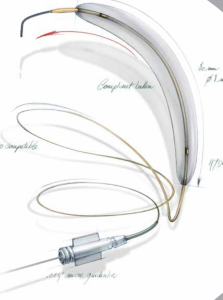In a Video technique demonstration / Case report Noda et al. from:
-
Neuroradiologie Interventionelle, CHU Limoges, Limoges, France
-
Neurosurgery, NTT Medical Center Tokyo, Shinagawa‑ku, Japan
-
Radiology Department, Universiti Kebangsaan Malaysia, Fakulti Perubatan, Cheras, Malaysia
-
Published inthe Journal of NeuroInterventional Surgery
with the purpose to demonstrate feasibility and safety of using a large compliant balloon positioned in a cortical vein to support microcatheter navigation for transvenous embolization of a brain AVM They concluded that the large compliant Copernic RC balloon provided stable “buttress” support in a cortical draining vein, enabling safe and successful microcatheter cannulation during TVE in a challenging bAVM case, without complications 1).
This video-based single‑case technique report suffers from severe limitations:
-
n=1 restricts external validity—no statistical support or comparison with standard microcatheter techniques
-
No quantitative bench testing or phantom models to define force thresholds, risks of venous rupture, or balloon‑catheter interaction
-
Balloon in cortical veins raises significant safety concerns: potential for endothelial injury, venous thrombosis, or rupture—no monitoring or follow‑up imaging provided
-
Technique complexity—introducing a compliant balloon into fragile veins may add procedural risk not fully acknowledged
-
No long‑term clinical outcomes documented; absence of angiographic follow‑up to confirm AVM obliteration or highlight delayed venous injury undermines claims
-
Lack of multi-operator reproducibility or ergonomic feasibility—unclear learning curve or required expertise
Final Verdict
This contribution is a rudimentary proof‑of‑concept overshadowed by major safety, validity, and reproducibility concerns. Valuable as an exploratory video, but not robust evidence.
Takeaway for Neurosurgeons
A novel balloon-assisted approach shows technical promise in select TVE scenarios—but red flags abound: extremely cautious use, rigorous safety protocols, and comparative studies are mandatory before adoption.
Bottom Line
One-case video demonstration only; attractive in concept but currently lacks scientific rigour and safety validation—far from practice-changing.
Numeric Rating (0–10)
2/10 – Innovative idea, but unjustified risk and devoid of follow‑up or comparative evidence.
Citation
-
Published online ahead of print June 24, 2025.
-
Corresponding author email: izzatarslan@gmail.com
